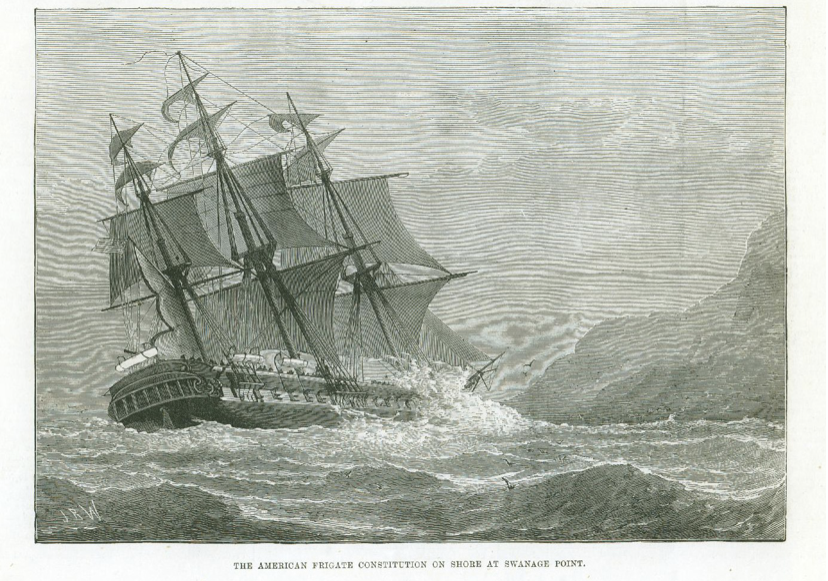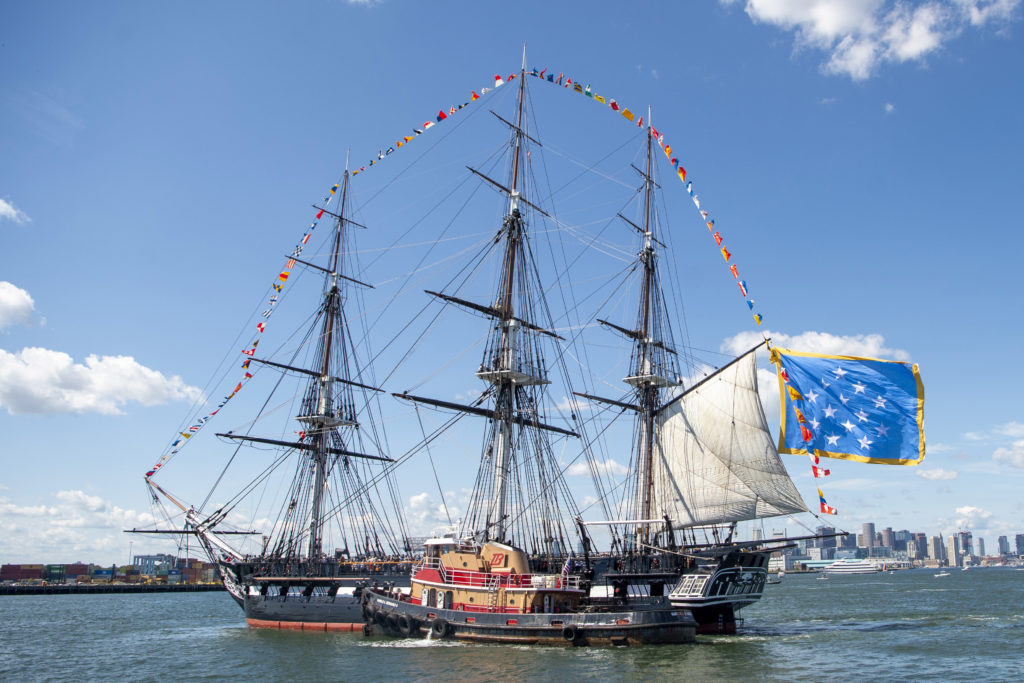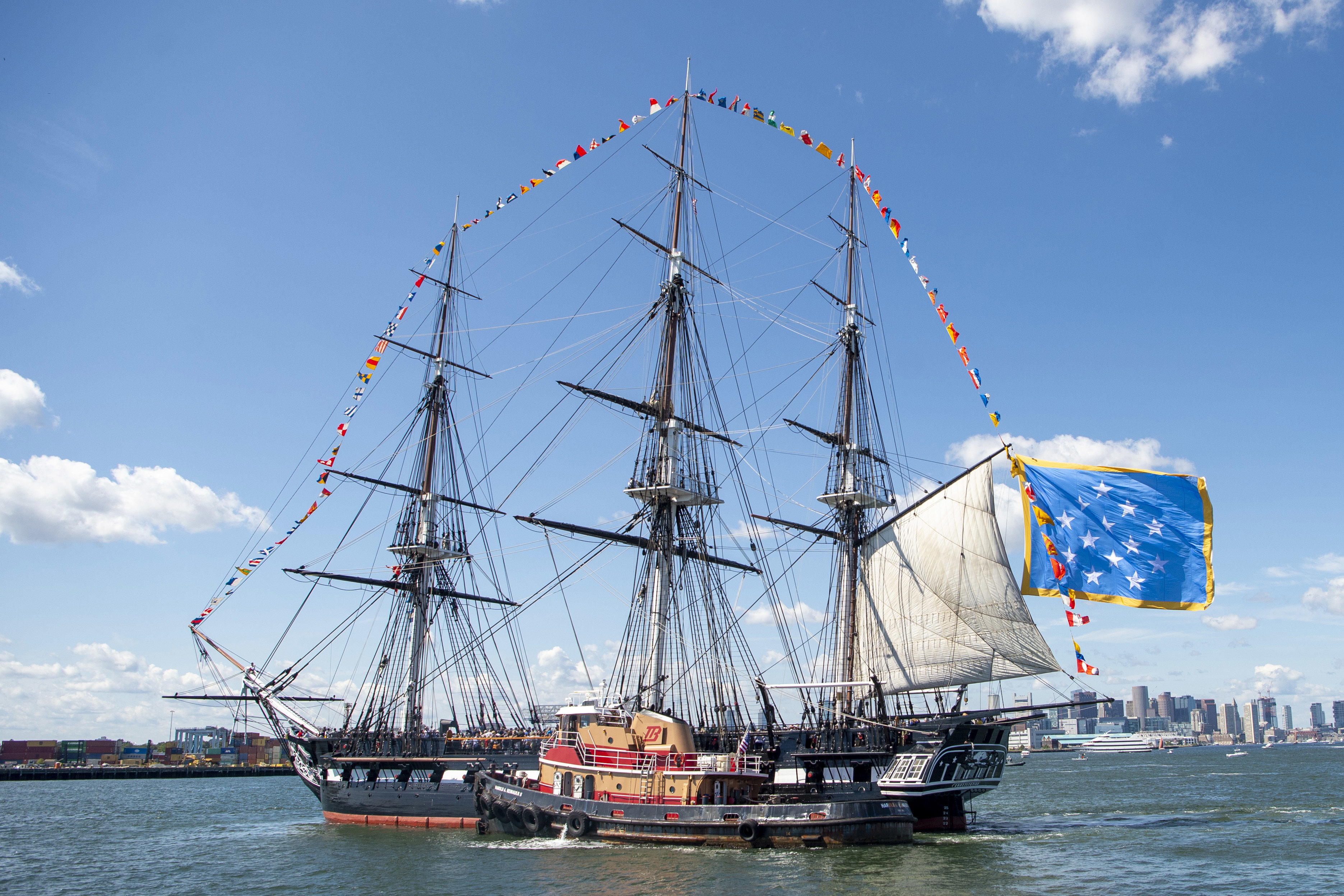USS Constitution’s last trans-Atlantic voyage almost proved to be its undoing. In 1878, representatives from the entire Western world descended on Paris, France and brought with them the latest innovations from their respective countries. The ambitiously named Exposition Universelle showcased the best art and technology, and for France, provided proof the country had recovered from the ravages of the Franco-Prussian War (1870-1871).
The U.S. Congress deemed Constitution the best choice for delivering the American exhibits to France, so in March of 1878, after undergoing a speedy refit and loading 738 tons of cargo (including three streetcars lashed to the spar deck), the old ship set sail for Europe. After a stormy passage of nearly a month, Constitution finally made Le Havre and disgorged its cargo into rail cars alongside the wharf.
The Exposition ran until November, so the ship and crew had seven months to while away at Le Havre. Captain Oscar Badger had the ship dry docked to repair some damage suffered in the crossing, and spent the rest of the time devising methods to keep his crew out of trouble.
At long last, with the event over, the crated exhibits returned on board and, on January 16, 1879, Constitution and its crew put to sea. Crossing the Atlantic in January is not for the faint of heart. When compounded by navigational errors, the results could be deadly. Just 10 hours from France, the ship had managed to outsail the navigator’s estimates by 30 miles, and at 2:00 in the morning the ship drove aground off the cliffs of Swanage, England. Thankfully, the weather remained calm. The next day, with the help of a steam tug, the ship was refloated and towed to Portsmouth, England. A swift visit to one of the Royal Navy’s dry docks enabled the dockyard personnel to replace some copper sheathing, the only damage suffered in the mishap.


The crew scrambled to jury rig the rudder using hempen hawsers and iron chain, but the first attempts ended in failure as the chains parted and the hawsers chafed through. All night long, the rudder continued to thump ominously against the stern, its many tons of oak, iron, and copper threatening to twist the stern post, start the surrounding planking, or rip itself free entirely. By 8:30 the next morning the crew managed to steady the rudder enough that men could go over the stern to attempt a more permanent fix. Underway again by January 30, the ship was heading for one of the most harrowing experiences of its long career. Buffeted by strong gales for almost 10 days, on February 13th, the ship suffered “frequent heavy thumps caused by seas striking stern and rudder.” At about 9:30 AM, the crew discovered that the top of the rudder had twisted off, rendering the tiller and wheel useless. In heavy seas, this was a perilous situation.
Dangling from bosun’s chairs over the stern, carpenter’s mate Henry Williams, assisted by captains of the top Joseph Matthews and James Horton, endured hours of repeated dunking in the frigid waters as they struggled to bore a hole in the rudder head and install a set of chains that would restore rudder control. Not only did they face the deadly chill, but the equipment could crush them without warning. At long last they succeeded, and Constitution bore away for Lisbon, Portugal, the closet port with dockyard facilities capable of repairing the ship.
For their heroism, all three men were awarded the Medal of Honor. Without their efforts, the ship, and probably many of the crew, would not have survived.
Not much is known of the three recipients. Henry Williams was born in Canada in 1834 and had been in the U.S. Navy since 1873. He received his carpenter’s warrant in 1880 and finally retired in 1896. Joseph Matthews was born in Malta in 1849, and died in Georgia in 1912. James Horton joined the U.S. Navy in Boston, where he was born in 1850. While the ship lay at Le Havre, he’d attempted to desert, was caught, court-martialed, fined three month’s pay, and clapped in irons for 30 days. Despite these transgressions, he certainly redeemed himself on February 13th!
With the homeward-bound voyage complete, the ship resumed its role as a training ship in July 1879. But the feats of heroism were not yet over. On November 16 of that year, two 3rd-class boys named Eugene Nodler and Merrit Bradford decided to desert from the ship while it lay at anchor off Norfolk, Virginia. Arrested by the Marine guard, they were on the verge of being taken below when Bradford wriggled away from his captor and dove overboard. He couldn’t swim and immediately began to sink. Seeing the boy’s distress, ship’s corporal James Thayer and master Aaron Ward dove overboard and kept him afloat until they were picked up by the ship’s boat. For this selfless act, Thayer received the Medal of Honor.
In 1958, the U.S. Congress chartered the Congressional Medal of Honor Society, which consists of all living recipients of the Medal, working to preserve the legacy of the Medal and its principles. Medals of honor are still awarded today.


The Author(s)
Matthew Brenckle
Research Historian, USS Constitution Museum
Matthew Brenckle was the Research Historian at the USS Constitution Museum from 2006 to 2016.
